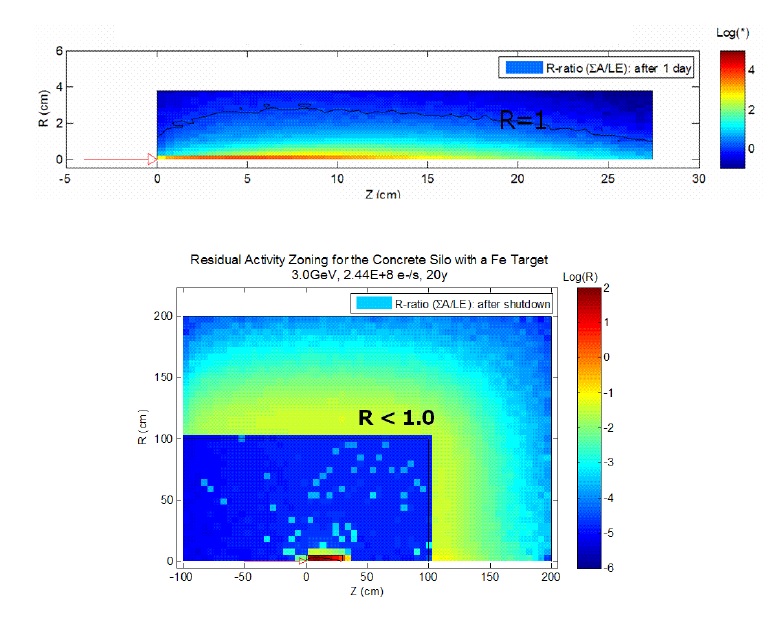Date: Thu, 8 Feb 2018 11:45:18 +0330
Hi
Dear Joachim and Paola
I am very grateful to you for your helpful response. Now my question is
whether I am able to determine residual activity zoning in the USRBIN plot
similar to attached figures by following the second approach you have
suggested to calculate exemption limit?
Kind Regards
Hamideh
PS, In attached figures R is the same as EC.
On Wed, Feb 7, 2018 at 8:30 PM, Joachim Vollaire <joachim.vollaire_at_cern.ch>
wrote:
> Dear Hamideh
>
> FLUKA will not calculate the zoning. It will calculate the activity.
>
> There are two approaches which can be used if you want to express the
> results in fraction of exemption limits (weighting by radiotoxicity):
>
> 1- You score RESNUCLEi (be careful to specify the correct volume to
> allow FLUKA to compute the specific activity in Bq/cmc), then weights the
> activity of each radionuclides by the exemption limit offline considering
> the density of the material if LE are expressed in activity by mass units
> (it is easy to post-process the tab_lis which is generated when averaging
> results of different runs). The exemption limits you must provide yourself
> (depending on the standard/regulation/country you are considering). This
> method has the advantage of giving you the individual contribution of each
> radionuclides to the EC values. The drawback is that the resolution is the
> one of the geometry as RESNUCLEi is a region based estimator. For bulky
> equipment or heterogeneous radiation fields you only get an “averaged”
> specific activity/LE faction over the whole object.
>
>
>
> 2- The second approach is to use a USRBIN mesh (score ACTOMASS) and
> weight online the contribution of each radionuclides by the corresponding
> exemption limit using the comscw.f routine. In order to call the routine,
> you must set the USERWEIGH what(6) to 3. At initialization (first time the
> routine is called) you should load the exemption limits to be used for the
> weighting, then each time you have a contribution you should weight the
> contribution using the exemption limit. The type of binning ISCNRG = 5
> corresponds to activity density (see the header of the routine). To select
> the exemption limit to use for the weighting you must include the common
> (RSNCCM). The arrays IARSDL(IPRSDL), IZRSDL(IPRSDL), ISRSDL(IPRSDL)contain
> A, Z and isomeric state (if any) of the isomer producing the activity
> (index IPRSDL). The advantage of this approach is that the resolution of
> the binning and is geometry independent. However it does not give you the
> information on individual radionuclides contribution.
>
> Cheers
>
> Joachim & Paola
>
>
>
>
>
> *From:* owner-fluka-discuss_at_mi.infn.it [mailto:owner-fluka-discuss_at_
> mi.infn.it] *On Behalf Of *Hamideh Jalali
> *Sent:* 04 February 2018 12:34
> *To:* fluka-discuss <fluka-discuss_at_fluka.org>
> *Subject:* [fluka-discuss]: Calculation exemption limit of radionuclides
>
>
>
> Dear FLUKA experts
>
> I am working on the problem of radioactive waste management. I found some
> references which says FLUKA can offer an
> application to define a radioactive waste zoning based on the concept of
> exemption limits for mixture of radionuclies:
>
> EC= sigma Ai/LEi which Ai is the specific activity of radionuclide i and
> LEi is the respective exemption limit.
>
> Could you please guide me how I can do such a calculation by FLUKA code?
>
> Best Regards
>
> Hamideh
>
__________________________________________________________________________
You can manage unsubscription from this mailing list at https://www.fluka.org/fluka.php?id=acc_info

(image/jpeg attachment: EC_limit.jpg)